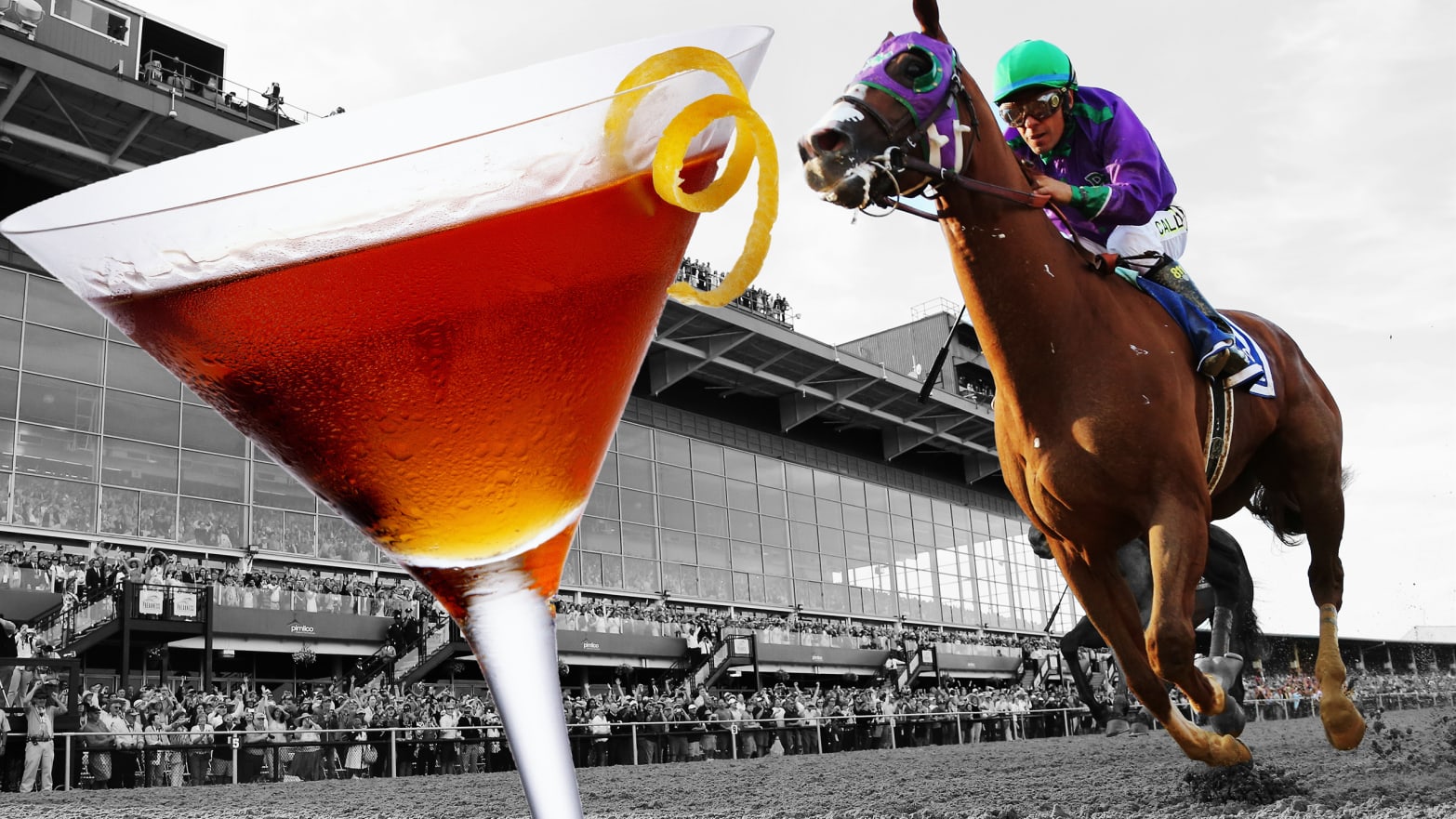It’s official: After filling four double cabinets in my kitchen and a few shelves in a closet, I have sworn off buying more drinking glasses.
I have rows of stemmed Irish Coffee glasses, a set of vintage gilded old-fashioned glasses painted with pistols and a whole field of Kentucky Derby glasses.
Every year at Churchill Downs on that storied first Saturday in May, an army of drink slingers is unleashed upon the crowd. They carry sloshing trays and they call out “MINT juLEP,” hitting that “julep” with the rhythm of a mockingbird’s call—which is fitting, given their persistent presence. Their tall highballs, packed with crushed ice, tufted with mint, painted on one side with the current year’s Derby logo and on the other with a list of all the past winners. I have, I’m guessing, with the inclusion of last year’s gift from a friend, thirty of them.
Hidden among my collection is just a single glass from the Preakness.
If the Run for the Roses is a high holiday—hats! parties! debauchery!—the Run for the Black Eyed Susans is a pot luck PTA dinner.
I’m sure someone collects Preakness glasses. I’m sure there’s a rack of them at a bar in Baltimore. On eBay, as I type, there are 498 results for “Preakness glasses,” so there is some enthusiasm for the souvenirs. (In contrast, a search for “Derby glasses” is currently returning a robust 4,952 results.)
Here’s the thing, though: the Preakness is a great race. Every year it decides whether the favorite—inevitably the winner of the Derby, despite the long odds that the horse wins both—is the real deal, or if he just got a lucky trip running in front of the Twin Spires. The Preakness is a scrappy race, with a first turn that comes up before the horses are fully settled into their racing order. It demands quick thinking from the jockeys, and tractability from the animals.
There should be Preakness parties.
The Preakness is made for parties. You can serve soft shell crabs, oysters, and National Bohemian beer. So, what’s going on?
Why don’t I, in fact, have as many Preakness glasses as I do Derby glasses? Part of the problem must be the drink.
Here’s the thing: When you hear the words “Kentucky Derby” there is a solid chance that the words “Mint Julep” follow like the slap back reverb in a rockabilly song. The Preakness has no such strong association. If you live in Baltimore, perhaps you think of the mess of impromptu parking lots that pop up in people’s yards around Old Hilltop.
The official drink of the Preakness Stakes is the Black Eyed Susan, which has bourbon, peach schnapps, vodka, orange juice and sour mix. Let’s just leave that alone.
So, I went scouring drinks books for alternative equine drinks.
What’s striking, almost immediately, is that we’ve been naming horses for a long time, and we’ve been naming drinks for a long time. And since people often approach things in the same manner, there’s a lot of crossover. No doubt some is unintended but some is also intended.
For instance, there have been eight thoroughbreds named Maidens Blush. The oldest being a British horse foaled in 1867, the most recent being two unrelated foals dropped in 1999. None of them have made anything of themselves except for the chestnut Maiden’s Blush from 1996 that was shipped to England and won in his only start, taking $9,123. It’s unlikely that the Maiden’s Blush Cocktails in Harry Craddock’s art deco 1930 Savoy Cocktail Book were inspired by any of these uninspiring horses, but one never knows. There’s a pretty solid connection between the bar and the track, after all.
Is the Foxtrot cocktail, also in the Savoy, named after the dance or a horse? There are nine race horses I could find named Foxtrot. Peter Pan was a hall of fame race horse, with seven major stakes wins to his credit, including the 1907 Belmont Stakes. It’s also a drink with equal parts gin, French vermouth, orange juice and peach bitters—at least that what it says in the Savoy, but I can’t believe a quarter of the drink is supposed to be peach bitters.
I’ve also found a Futurity cocktail and a Jockey Club Cocktail and a Saratoga Cocktail, and a Man o’ War cocktail.
Lucky for us, there’s also a very good historic Preakness cocktail. Why the race doesn’t use this one I don’t know. The oldest recipe I found for it is in the 1957 Old Mr. Boston De Luxe Official Bartender’s Guide. In subsequent editions, it shows up again and again, hiding in plain sight. (The unbelievably handy Mr. Boston database contains the recipes from almost all of the editions of the brand’s ubiquitous bartending guide that was first published after Prohibition ended.) It’s a delicious mix of straight rye whiskey, which was a Maryland staple, sweet vermouth and a bit of herbaceous Benedictine. It’s like a Manhattan with a hint of the turf! I’ll be mixing up a batch of these this Saturday night, while I watch the 142nd Preakness Stake. Now, I just need to find the perfect glass.
The Preakness
Ingredients:
1.5 oz Straight rye whiskey
.75 oz Sweet vermouth
.25 oz Benedictine
dash Angostura Bitters
Glass: Cocktail
Garnish: Lemon twist
Directions:
Add all the ingredients to a mixing glass and fill with ice. Stir and strain into a chilled cocktail glass. Garnish with a lemon twist.

